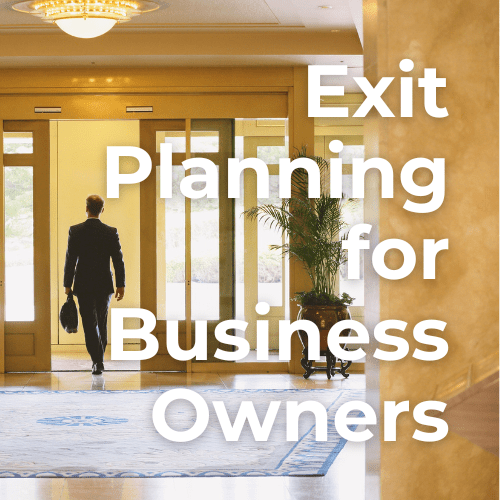
Exit Planning for Business Owners: The Complete Guide to a Profitable and Stress-Free Business Exit
Share
Most business owners wait too long to plan their exit; often until burnout, a health scare, or a sudden offer forces the decision. The result? Undersold businesses, messy handovers, and regrets that could’ve been avoided. Exit planning for business owners is essential if you want to have a successful business exit strategy.
But a well-planned exit isn’t just about getting out. It’s about setting up your business, and yourself, for the next stage of life with confidence, clarity, and cash in the bank.
This guide walks you through the exact steps to start exit planning today, so you can sell (or step back) on your own terms.
What Is Exit Planning?
Exit planning is the strategic process of preparing your business for sale or succession, with the goal of maximising value, ensuring a smooth transition, and achieving your personal and financial goals.
It’s not just about when you exit. It’s about how.
Think of it like renovating a home before putting it on the market; except this home also needs to run without you, have solid financials, and impress a buyer with a sharp eye.
Why Exit Planning Matters More Than You Think
Most owners overestimate their business’s value and underestimate the time it takes to exit well. A rushed sale or poorly prepared business can lead to:
- A lower sale price
- Fewer (or no) offers
- Extended handover periods
- Complex legal and tax issues
- Damaged brand or team morale
The earlier you start, the more control you have.
When Should You Start Exit Planning?
Answer: Yesterday.
But if not yesterday, then today; ideally 12 to 36 months before your ideal exit date.
This gives you time to:
- Clean up financials
- Reduce owner dependence
- Implement systems
- Build transferable value
- Minimise tax impacts
- Attract strategic buyers
Even if you’re not ready to sell now, you should be ready to sell, because life doesn’t always wait.
The 7 Key Pillars of a Successful Exit Plan
1. Business Valuation
Know what your business is worth today, based on market benchmarks and actual buyer behaviour.
➡️ Use a Business Valuation Report to get clarity.
2. Clean Financials
Messy books kill deals. Get your P&L, balance sheet, and cash flow statements in shape.
- Remove personal expenses
- Standardise salaries
- Identify one-off costs
3. Owner Independence
Can your business run without you? If not, you don’t have a business. You have a job with overheads.
✅ Systemise operations
✅ Delegate key roles
✅ Document SOPs (Standard Operating Procedures)
4. Team & Culture Stability
Buyers don’t just buy revenue; they buy continuity.
- Lock in key staff with incentives
- Show low turnover and strong culture
5. Customer & Revenue Diversity
Customer concentration = risk.
- Aim for no customer contributing more than 15–20% of revenue
- Highlight recurring revenue where possible
6. Legal & Tax Readiness
Your business structure could cost you tens of thousands in unnecessary tax if not optimised before sale.
✔️ Review with your accountant
✔️ Ensure contracts are current
✔️ Address IP ownership and liabilities
7. Your Personal Goals
What do you want after the sale?
- Retirement?
- Another venture?
- Passive income?
Your exit strategy should align with your personal financial freedom plan.
Common Exit Planning Mistakes
❌ Leaving it too late
❌ Believing your business is worth “2x revenue” without data
❌ Being emotionally unprepared
❌ Underestimating due diligence
❌ Ignoring deal structure and earn-outs
The best exits are boring. They’re smooth, clean, and free of surprises.
How to Start Exit Planning Today (Even If You're Not Ready to Sell)
-
Get a Business Valuation Report
Understand your current position and value gaps. -
Complete a Business Sale Readiness Report
See how your business stacks up across 8 core valuation drivers. -
Schedule a 30-minute Exit Strategy Call
Map out a custom 90-day plan to improve your business’s value. -
Start your “Owner Exit Sprint”
Dedicate 90 days to systemisation, financial hygiene, and team alignment.
Exit Planning FAQs
Q: How do I know when it’s the right time to sell?
A: Ideally when the business is growing, your systems are strong, and you don’t have to sell.
Q: How long does it take to exit a business?
A: From prep to payout, 6–24 months is typical. Faster exits often come at a discount.
Q: Can I sell a business that depends on me?
A: Yes, but it will likely reduce your sale price or extend your involvement post-sale.
Remember This...
The smartest business owners treat exit planning like growth planning, it’s just a different endgame.
You don’t build to sell.
You build so that you can sell.
Then it’s your choice if you do.
✅ Ready to Start?
📩 Download Your Free Business Valuation & Sale Readiness Reports
🔗 Get the Reports
📞 Book a Free Exit Strategy Call with Sam
🔗 Book Now
Related Reads
- Business Coaching in Australia: The Complete 2025 Guide
- Business Exit Strategy: How to Leave Your Business Without Losing Value or Control
- 5 Common Mistakes Australian Owners Make When Selling Their Business
- How to Buy a Business for Sale in Australia: The Ultimate Investor's Guide
- What the Systems Tell You About the Business: A Smart Investor’s Guide
